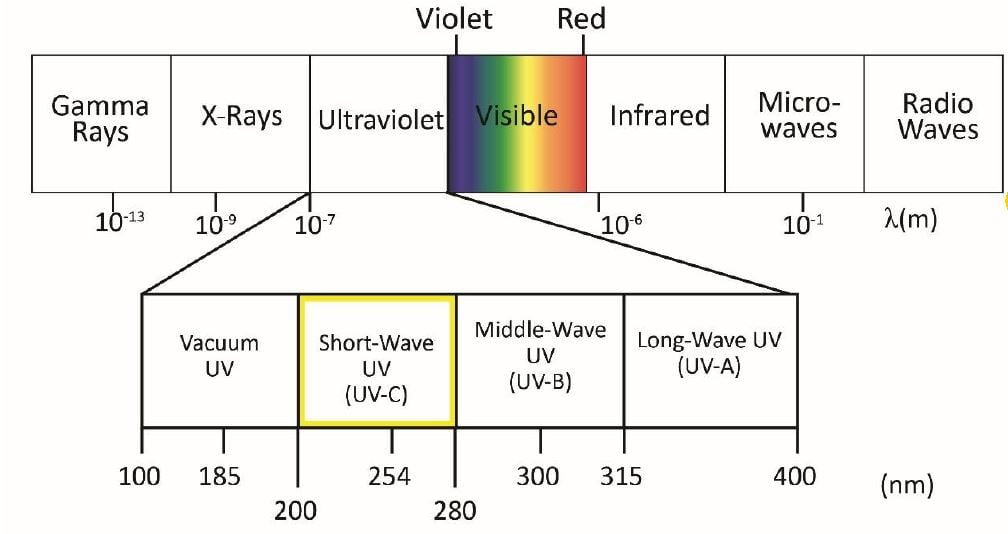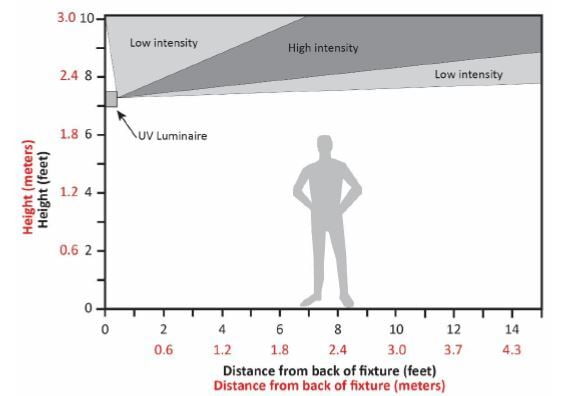Page Under Construction
According to the IES Report released on April 2020 (referenced & linked below) "Yes, if the virus is directly illuminated by UV-C at the effective dose level. UV-C can play an effective role with the other methods of disinfection, but it is essential that individuals be protected to prevent UV hazards." The correct dosage depends on a range of variables that should be considered based on the specific application.
- Install HEPA (High Efficiency Particulate Air) Filtration Systems - These filters are able to trap 99.97 percent of particles that are 0.3 microns and above in size. With increased filtration, viruses, bacteria and mold has a higher possibility of being filtered out by the high efficiency HEPA air filtration.
- Increase HVAC air changes per hour (ACH) - The typical HVAC system provides fresh make-up air between 10-15% of its rated air-flow capacity. At this rate, an effective ACH of 1-2 is achieved. By increasing the ACH, by principle of dilution from increasing ACH to 6-12 per hour, the risk of an infection by an airborne viral particle is reduced. This increased ACH can be quite challenging for existing HVAC systems as these systems are not be rated to handle the additional cooling and heating capacity requirements to properly condition the significant increase in outside air. In regions of the country that
- Upper-Room GUV Air Disinfection - UV-C lighting is installed between 7-10' above the floor, where the light is directed up towards the ceiling to mitigate risk of exposure to occupants. According to the IES Report released on April 2020, this method has been widely used and proven to be quite effective in treating large common spaces. The use of a circulation fan or a single room HVAC system will boost effectiveness as the air movement will increase the probability of particulate exposure to the UV-C lighting. If the room is serviced by a central AHU, other challenges are posed as the upper-room GUV might be sized for low velocity air movement (increased exposure time with lower (wattage) as opposed to an in-duct system which needs a high wattage system because of the reduced dosage duration.
- Modular Room Air Cleaners - These modular units have grown in popularity within the past 5 years on residential applications because of their limited size. The units are typically equipped with both a HEPA filter and a UV-C lamp that continuously disinfects the recirculated air. The localized re-circulation of air through the unit increases the possibility of particles becoming trapped through filtration as well as increases the probability of viral and bacterial inactivation through repeated exposure and dosage by the UV-C lamp.
- High Intensity Mobile UV-C Carts - These mobile modular units are commonly used within in hospitals for treatment of entire rooms. These high intensity carts are able to disinfect a space through direct and indirect exposure of surfaces and air to the UV-C light. Indirect disinfection works through surface reflectivity of the UV-C light.
- In-duct GUV-C Installations - This installation is ideal for multi-room variable-air-volume (VAV) or constant-air-volume (CAV) AHUs that has a capacity of 10 cooling tons or greater. It is common place to have a single AHU (Air Handling Unit) service multiple offices and conference rooms. Even with adequate social distancing, use of masks and hand sanitizing, the risk of airborne viral particles being drawn into a AHU return and being distributed throughout its service space is very high. This is especially true if the AHU is not equipped with HEPA filtration. On these specific applications, the installation of an in-duct GUV-C system provides the best option to reduce cross contamination by common AHU Systems. A more idealistic installation might include a Modular Room Air Cleaner (reduces contaminants in the room), HEPA filtration (traps 99.97% of contaminants 0.3 to 1.0 microns in size) and the installation of an in-duct GUV-C system to treat recirculated air.
"Germicidal effectiveness is proportional to the exposure dose (radiant exposure, typically measured in millijoules per square centimeter (mJ/cm2). A nonlinear relationship exists between UV exposure and germicidal efficacy. For example, if a certain UV exposure kills 90% of a bacterial population (frequently referred to as "one-log kill"), doubling the exposure time or intensity can kill only 90% of the residual 10% for an overall efficacy of 99% ("two-log kill"). Likewise, a 50% decrease in dose or exposure time decreases germicidal efficacy only from 99% to 90%."
"Humidity can reduce the effectiveness of germicidal UV radiation." "To be effective in practice, achieving two log-kills (99% inactivation) is frequently accepted."
Based on the sizing recommendations from IES' report, we understand that an induct GUV installation offers the greatest challenges as available duct length and air velocity through the duct creates significant variables in the possible dose rates to achieve the 99% inactivation. in high humidity or dirty (not properly filtered) air situations, the suspended water vapors and dust particles can pose even greater challenges these factors can refract and block the UV lights direct treatment of the air, hence reducing the overall dosage rate needed to achieve the desired inactivation rate.
According to the IES Committee Report, "Two hospital controlled studies have shown upper-room GUV to be 80% effective against TB spread. Even when GUV is confined to the upper room, good air mixing (ideally with low-velocity ceiling fans but easily accomplished by other types of forced-air ventilation) results in a very high equivalent ACH (air change per hour) in the lower, occupied space - estimated to be an additional 24 ACH in a South African Study.
With the implementation of proper social distancing, and in multi-zone AHU's that services many different rooms, the in-duct GUV system delivers the greatest impact. If a site is looking to implement GUV lighting for infection control, tt can be impractical to install Upper Air or portal air cleaners in each office or conference room. Attacking the need at a centralized point reduces the cost impact from multiple installations (Electrical and Implementation Design), occupant training (Safety), and making changes in room layout and aesthetics.
EES offers a full suite of Germicidal UV-C Products. Please visit www.GermicidalUltraviolet.com
Information provided above includes content from the following references: Illuminating Engineering Society (IES CR-2-20-V1), ASHRAE 2019 Handbook Chapter 62, Ultraviolet Air and Surface Treatment
Links to official documents can be accessed through the following links: Illuminating Engineering Society (IES CR-2-20-V1), ASHRAE 2019 Handbook Chapter 62, Ultraviolet Air and Surface Treatment



